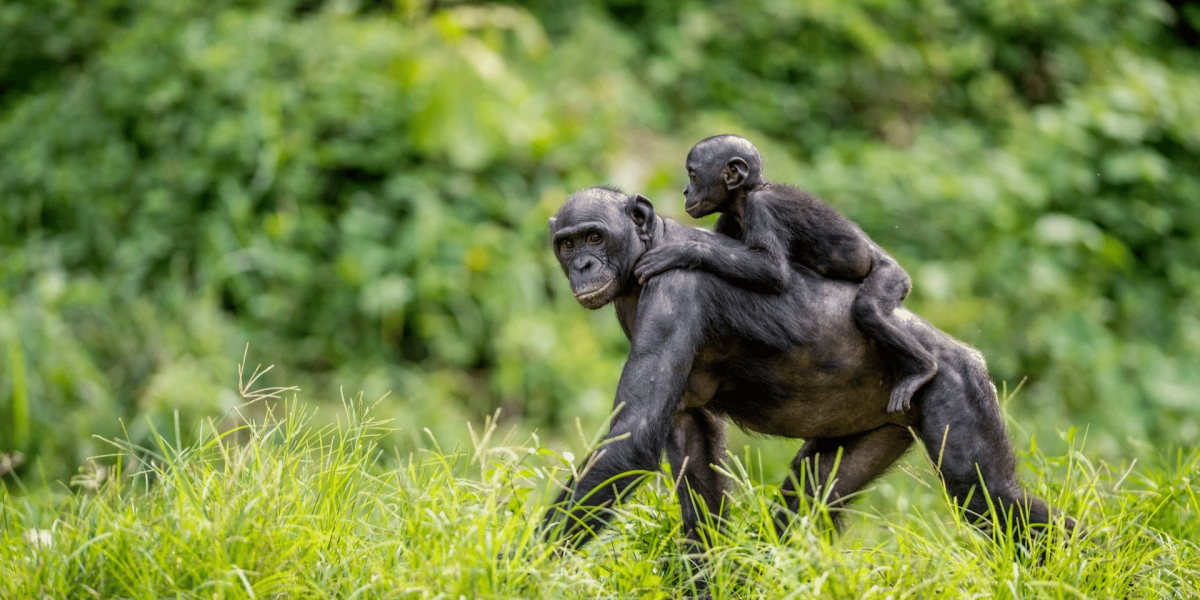Bonobos, often referred to as the “forgotten ape,” are one of our closest living relatives, sharing approximately 98.7% of our DNA. Despite their lesser-known status compared to their more famous relatives, chimpanzees, bonobos possess remarkable similarities to humans in terms of behavior, social structure, and cognitive abilities. This article delves into the intriguing parallels between bonobos and humans, shedding light on our shared evolutionary heritage and the fascinating connections that bind us together.
Bonobos, scientifically known as Pan paniscus, inhabit the dense rainforests of the Democratic Republic of the Congo in Central Africa. Like humans, bonobos are highly social creatures, living in complex communities characterized by cooperation, empathy, and communication. Despite their physical differences, bonobos exhibit a range of behaviors and traits that closely resemble those observed in humans, offering valuable insights into our own evolutionary past and the nature of our shared ancestry.
The Genetic Connection
Genetic studies have revealed that bonobos and humans share a common ancestor that lived approximately 6-7 million years ago. Despite diverging evolutionary paths, our genetic similarities underscore the close relationship between these two species. Comparative genomics has highlighted numerous shared genetic sequences and regulatory regions between bonobos and humans, providing further evidence of our shared evolutionary heritage.
Social Structure and Cooperation
Bonobos, like humans, live in complex social groups characterized by cooperation, mutual aid, and social bonding. Unlike their more aggressive chimpanzee cousins, bonobos are known for their peaceful and egalitarian social structure, where conflicts are often resolved through reconciliation, grooming, and sexual behavior. Bonobos exhibit a high degree of social intelligence, maintaining intricate social relationships and alliances within their communities.
Cooperation and Altruism
Studies have shown that bonobos, like humans, engage in cooperative behaviors such as food sharing, cooperative hunting, and reciprocal grooming. Bonobos demonstrate a remarkable level of empathy and altruism towards their fellow group members, readily offering assistance and support when needed. These cooperative tendencies are believed to have played a crucial role in the evolutionary success of both species, fostering social cohesion and strengthening group bonds.
The Role of Empathy in Social Cohesion
Empathy plays a central role in the social dynamics of bonobo communities, enabling individuals to understand and respond to the emotions and needs of others. Bonobos demonstrate a keen ability to empathize with their fellow group members, offering comfort, reassurance, and support in times of distress. This capacity for empathy fosters social cohesion and cooperation within bonobo communities, allowing them to maintain stable and harmonious relationships over time.
Communication and Language
Communication is a fundamental aspect of social life for both bonobos and humans, serving as a means of conveying information, expressing emotions, and establishing social connections. While bonobos lack the complex language systems of humans, they possess sophisticated forms of communication involving vocalizations, gestures, facial expressions, and body language. Bonobos are capable of conveying a wide range of emotions and intentions through their vocalizations and gestures, allowing them to coordinate group activities, negotiate conflicts, and form alliances.
Gestural Communication
Bonobos are particularly adept at using gestures to communicate with one another, employing a diverse repertoire of manual and facial expressions to convey their thoughts and feelings. Studies have shown that bonobos are capable of using gestures flexibly and contextually, adapting their communication strategies based on the social dynamics and environmental cues present in their surroundings. Gestural communication plays a crucial role in maintaining social cohesion and resolving conflicts within bonobo communities.
Vocalizations and Facial Expressions
In addition to gestures, bonobos use vocalizations and facial expressions to convey information and express emotions. Bonobos produce a wide range of vocalizations, including screams, grunts, and panting sounds, each of which serves a specific communicative function. Facial expressions also play an important role in bonobo communication, with individuals using subtle changes in facial muscles to convey their mood, intentions, and social status. Together, vocalizations and facial expressions form an integral part of bonobo communication, facilitating social interaction and cooperation within their communities.
Cognitive Abilities and Problem-Solving
Bonobos possess advanced cognitive abilities and problem-solving skills, similar to those observed in humans. These include tool use, spatial reasoning, and abstract thinking, all of which are essential for navigating their complex social and ecological environments. Bonobos have been observed using a variety of tools in the wild, including sticks for extracting termites from mounds, leaves for scooping water, and rocks for cracking nuts.
Tool Use and Innovation
Tool use is a hallmark of primate intelligence, and bonobos are no exception. Studies have documented numerous instances of tool use among wild bonobos, ranging from using sticks to extract insects from crevices to using leaves as makeshift umbrellas to shield themselves from rain. Bonobos demonstrate a remarkable ability to innovate and adapt their tool use techniques to suit different tasks and environmental conditions, highlighting their cognitive flexibility and problem-solving prowess.
Social Learning and Cultural Transmission
Bonobos exhibit a high degree of social learning, with individuals acquiring new skills and behaviors through observation, imitation, and instruction from their peers. This form of cultural transmission allows bonobos to pass on knowledge and traditions from one generation to the next, leading to the development of complex cultural practices within bonobo communities. Social learning plays a crucial role in shaping the cognitive abilities and behavioral repertoire of bonobos, allowing them to adapt and thrive in their ever-changing environment.



















